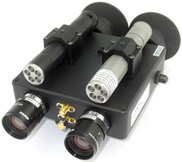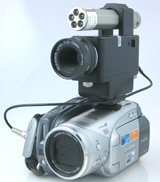
 |
Ultraviolet Forensics Imaging SystemsOculus Photonics has developed novel tools for forensic investigators to examine crime scenes with invisible light. In the past, this was done with photographic film, and it was a difficult technique to master. Digital cameras and electronic imaging sensors make UV imaging a snap. Note that Oculus products are meant to be used in conjunction with forensic DSLR systems like the Fuji IS/Pro which can capture high resolution longwave UV images of evidence, or in conjunction with other methods of processing evidence like dust print lifters. The UVScanner does not record images, it is a viewer. The UVCorder records standard definition longwave UV video which can have still images extracted from it using video editing software. SpectraScanner TM
See Products for more on SpectraScanner
 UVScanner TMThe UVScanner is a handheld viewer that looks and feels like a pair of binoculars. This is a longwave UV viewer with LCD displays for both eyes, dual near-UV illuminators on top, and rubber eyecups to block ambient light, permitting UV imaging in bright light. A variety of lenses options are available. See Products for more on UVScanner
How is the UVScanner different from RUVIS?RUVIS is primarily a short-range method, restricted to a few feet at most. This is because of the high degree to which the light sources based on gas-discharge lamps spread out. Longwave UV imaging can take advantage of very bright LED-based light sources. These forensic flashlights can put out several watts or more of 365nm UV light. This enables a much wider area to be examined quickly, and from much farther away, with greater safety. An investigator can flood an entire floor and look for trace evidence very quickly. RUVIS requires shortwave UV illumination (254 nm wavelength). This radiation is very irritating to the eyes and the skin. Full face masks and Tyvek suits must be worn in areas that are highly illuminated with shortwave UV radiation. The longwave UV sources are much safer to work around. They are 365 nm wavelength. UV safety glasses and sunscreen on exposed skin are more than enough protection for even long-duration exposure. The UVScanner uses a special silicon CCD video camera to produce analog video that is fed to dual near-eye LCD displays. The dual displays are much less fatiguing to use for extended periods compared to looking into a RUVIS device with one eye. While in use, the UVScanner can be connected to a standard NTSC video monitor or recording device like a mini-DV video tape recorder for training and evidence collection via a video cable.
|

